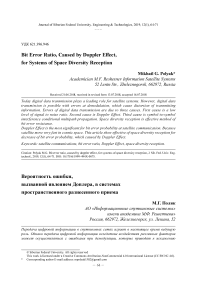Bit error ratio, caused by Doppler effect, for systems of space diversity reception
Автор: Polyak Mikhail G.
Журнал: Журнал Сибирского федерального университета. Серия: Техника и технологии @technologies-sfu
Статья в выпуске: 1 т.12, 2019 года.
Бесплатный доступ
Today digital data transmission plays a leading role for satellite systems. However, digital data transmission is possible with errors at demodulation, which cause distortion of transmitting information. Errors of digital data transmission are due to three causes. First cause is a low level of signal to noise ratio. Second cause is Doppler Effect. Third cause is symbol-to-symbol interference conditional multipath propagation. Space diversity reception is effective method of bit error resistance. Doppler Effect is the most significant for bit error probability at satellite communication. Because satellite move very fast in cosmic space. This article show effective of space diversity reception for decrease of bit error probability, which caused by Doppler Effect.
Satellite communications, bit error ratio, doppler effect, space diversity reception
Короткий адрес: https://sciup.org/146279574
IDR: 146279574 | DOI: 10.17516/1999-494X-0075
Список литературы Bit error ratio, caused by Doppler effect, for systems of space diversity reception
- William C. Jakes. Microwave mobile communications. 1974
- Voelker H.B. Phase-Shift Keying in Fading Channels, Proc. IEEE, 107, Part B, January 1960, 31
- Bello P.A. and Nelin B.D. The Influence of Fading Spectrum on the Binary Error Probabilities of Incoherent and Differentially Coherent Matched Filter Receivers. IRE Trans. Comm, Systems, June 1962, 160-168.
- Rice S.O. Mahematical Analysis of Random Noise, Bell System Tech. J. 23, July 1944, 282332; 24, January 1945, 46-156.
- Rice S.O. Statistical Properies of a Sine Wave Plus Rendom Noise», Bell System Tech. J. 27, January 1948, 109-157.
- Bernard Sklar. Digital Communications. Fundamentals and Applications. Second edition.: Perevod s angliyskogo. Moscow: Izdatelskiy dom «Villiams», 2003. 1104.
- Бордовицына Т.В. Технологии глобального позиционирования (GPS/ГЛОНАСС). Электронное учебное пособие. Томск, 2007.


